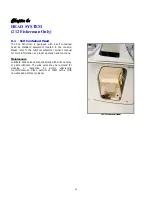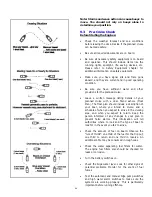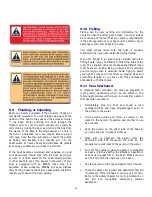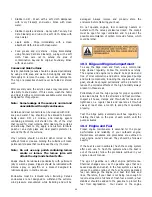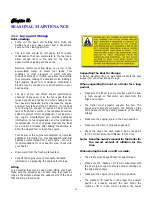
Note: Storms and wave action can cause buoys to
move. You should not rely on buoys alone to
determine your position.
9.3 Pre-Cruise
Check
Before Starting the Engines:
• Check the weather forecast and sea conditions
before leaving the dock. Decide if the planned cruise
can be made safely.
• Be sure all required documents are on board.
• Be sure all necessary safety equipment is on board
and operative. This should include items like the
running lights, spotlight, life saving devices, etc.
Please refer to Safety Equipment chapter for
additional information on safety equipment.
• Make sure you have signal kits and flare guns
aboard, and they are current and in good operating
condition.
• Be sure you have sufficient water and other
provisions for the planned cruise.
• Leave a written message listing details of your
planned cruise with a close friend ashore (Float
Plan). The float plan should include a description of
your boat, where you intend to cruise, and a
schedule of when you expect to arrive in the cruising
area, and when you expect to return. Keep the
person informed of any changes in your plan to
prevent false alarms. This information will tell
authorities where to look and the type of boat to
look for in the event you fail to arrive.
• Check the amount of fuel on board. Observe the
“rule of thirds”: one third of the fuel for the trip out,
one third to return and one third in reserve. An
additional 15% may be consumed in rough seas.
• Check the water separating fuel filters for water.
The engine fuel filters also should be checked for
leaks or corrosion.
• Turn the battery switches on.
• Check the bilge water level. Look for other signs of
potential problems. Monitor for the scent of fuel
fumes.
• Test the automatic and manual bilge pump switches
and high water alarm switches to make sure the
systems are working properly. This is particularly
important before running offshore.
44
Summary of Contents for 180 Sportsman
Page 2: ...2...
Page 4: ...4...
Page 7: ...180 FISHERMAN SPECIFICATIONS 7...
Page 8: ...180 SPORTSMAN SPECIFICATIONS 8...
Page 9: ...202 FISHERMAN SPECIFICATIONS 9...
Page 10: ...212 FISHERMAN SPECIFICATIONS 10...
Page 18: ...18...
Page 39: ...SAFETY LABELS 2601 1124 39...
Page 40: ...180 FISHERMAN 180 SPORTSMAN CAPACITY LABELS 40...
Page 41: ...202 212 FISHERMAN CAPACITY LABELS 41...
Page 61: ...Appendix A SCHEMATICS 180 FISHERMAN INSTRUMENT PANEL 61...
Page 62: ...Appendix A SCHEMATICS 180 SPORTSMAN INSTRUMENT PANEL 62...
Page 63: ...Appendix A SCHEMATICS 202 212 FISHERMAN INSTRUMENT PANEL 63...
Page 68: ...Appendix A SCHEMATICS 180 FISHERMAN 180 SPORTSMAN TRAILER DRAWING 68...
Page 69: ...Appendix A SCHEMATICS 202 212 FISHERMAN TRAILER DRAWING 69...
Page 70: ...Appendix A SCHEMATICS 180 FISHERMAN OVERHEAD LAYOUT 70...
Page 71: ...Appendix A SCHEMATICS 180 SPORTSMAN OVERHEAD LAYOUT 71...
Page 72: ...Appendix A SCHEMATICS 202 FISHERMAN OVERHEAD LAYOUT 72...
Page 73: ...Appendix A SCHEMATICS 212 FISHERMAN OVERHEAD LAYOUT 73...
Page 77: ...MAINTENANCE LOG 77...
Page 78: ...MAINTENANCE LOG 78...
Page 80: ...Appendix D BOAT ACCIDENT REPORT 80...
Page 81: ...81...
Page 87: ...Appendix F TROUBLESHOOTING GUIDE 87...
Page 88: ...TROUBLESHOOTING GUIDE 88...
Page 89: ...TROUBLESHOOTING GUIDE 89...
Page 90: ...TROUBLESHOOTING GUIDE 90...
Page 91: ...TROUBLESHOOTING GUIDE 91...





